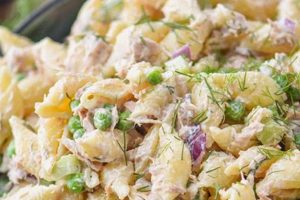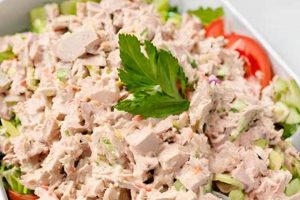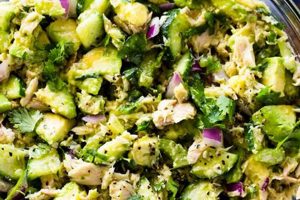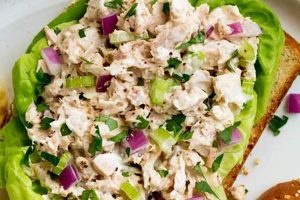A basic preparation of this lunchtime staple typically involves canned tuna, mayonnaise, and seasonings. Additions might include celery, onion, relish, or hard-boiled eggs. It’s commonly served between two slices of bread, but can also be enjoyed on crackers, lettuce wraps, or as a filling for tomatoes or avocados.
Quick, affordable, and protein-rich, this easily customizable dish is a convenient meal option for various occasions. Its adaptable nature allows for variations based on dietary preferences and available ingredients, making it a perennial favorite. From packed lunches to picnics, its versatility has cemented its place in culinary history as a practical and satisfying dish.
The following sections will delve into specific ingredient recommendations, step-by-step instructions for preparation, and suggestions for creative variations to elevate this classic meal.
Tips for a Superior Tuna Salad Sandwich
Elevating this simple classic requires attention to detail and an understanding of flavor balance. The following tips offer guidance on achieving optimal results.
Tip 1: Tuna Selection Matters: Opt for high-quality canned tuna packed in water or oil, depending on preference. Solid or chunk light tuna offers a firmer texture, while flaked light tuna provides a smoother consistency.
Tip 2: Mayonnaise Mastery: The quality and quantity of mayonnaise significantly impact the final product. Experiment with different brands and types, such as light or olive oil-based mayonnaise, to find a preferred flavor profile. Start with a small amount and add more as needed to achieve desired creaminess.
Tip 3: Seasoning Strategies: Classic seasonings include salt, pepper, and celery seed. Enhance the flavor profile with additions like dill, paprika, onion powder, or garlic powder. Taste and adjust seasonings throughout the preparation process.
Tip 4: Texture Enhancement: Finely diced celery and red onion provide a satisfying crunch. Consider incorporating chopped hard-boiled eggs, pickles, or water chestnuts for added textural complexity.
Tip 5: Bread Selection: The bread choice plays a crucial role. Hearty whole-wheat, crusty sourdough, or classic white bread all offer different textures and flavor pairings. Lightly toasting the bread prevents sogginess.
Tip 6: Freshness is Key: For optimal flavor, prepare the tuna salad shortly before serving. If making in advance, store it in an airtight container in the refrigerator and consume within two days.
Tip 7: Creative Additions: Elevate the sandwich with additions like lettuce, tomato, avocado, or sprouts. A thin layer of Dijon mustard or a sprinkle of hot sauce can add a flavorful kick.
By following these tips, one can transform a simple tuna salad sandwich into a truly satisfying and flavorful experience.
The following section provides a concluding overview and highlights the enduring appeal of this culinary classic.
1. High-quality Canned Tuna
High-quality canned tuna plays a pivotal role in a simple tuna salad sandwich recipe. The tuna’s quality directly impacts the overall flavor, texture, and nutritional value of the sandwich. Tuna packed in water or oil offers distinct characteristics. Water-packed tuna tends to be leaner, while oil-packed tuna provides a richer flavor and moister texture. Selecting premium brands often signifies better sourcing and processing practices, resulting in a superior product. For instance, choosing tuna sourced from sustainable fisheries ensures responsible practices are supported. Solid or chunk light tuna generally delivers a firmer texture compared to flaked light tuna, influencing the sandwich’s final consistency.
The importance of high-quality canned tuna extends beyond taste and texture. It contributes essential nutrients like protein and omega-3 fatty acids. Opting for tuna packed in water minimizes added fat and calories. Conversely, oil-packed tuna, particularly those packed in olive oil, can offer beneficial monounsaturated fats. This understanding enables informed choices aligned with individual dietary needs and preferences. Practical implications include selecting tuna with lower sodium content to control overall sodium intake. Furthermore, examining labels for additives or preservatives allows consumers to make health-conscious decisions.
In conclusion, the selection of canned tuna significantly influences the simple tuna salad sandwich recipe’s success. Prioritizing quality ensures a flavorful, nutritious, and satisfying meal. Considering factors like packing liquid, texture, sourcing, and nutritional content empowers informed choices aligned with individual dietary goals and preferences. This awareness transforms a simple sandwich into a carefully considered culinary creation.
2. Suitable Mayonnaise
Mayonnaise serves as a crucial binding agent and flavor enhancer in a simple tuna salad sandwich recipe. Its quality and type significantly influence the final product’s overall taste, texture, and consistency. Classic mayonnaise, typically made with oil, eggs, and vinegar, provides a creamy texture and tangy flavor that complements the tuna. Variations, such as light mayonnaise or those made with olive oil, offer alternative flavor profiles and reduced fat content. Choosing a suitable mayonnaise depends on individual preferences and dietary considerations. For example, a light mayonnaise might be preferred for a lighter, less calorie-dense sandwich, while a full-fat mayonnaise contributes a richer flavor and creamier texture. The quantity of mayonnaise used also plays a vital role. Too little can result in a dry, crumbly mixture, while too much can make the sandwich overly moist and difficult to handle. Striking the right balance ensures a cohesive mixture that binds the ingredients together while enhancing their flavors.
Practical implications of mayonnaise selection extend beyond taste and texture. Certain brands contain added sugars or preservatives, influencing the sandwich’s nutritional value. Considering ingredient lists and nutritional information allows informed choices. Furthermore, the type of oil used in the mayonnaise affects the overall flavor profile. Mayonnaise made with olive oil imparts a distinct flavor compared to those made with other vegetable oils. Experimenting with different brands and types allows individuals to discover preferred flavor combinations. For instance, some may prefer the robust flavor of olive oil mayonnaise, while others may opt for the classic taste of traditional mayonnaise. This exploration adds depth to the simple tuna salad sandwich recipe, transforming it from a basic meal into a personalized culinary experience.
In summary, the selection of mayonnaise is paramount in achieving a successful simple tuna salad sandwich recipe. Its quality, type, and quantity contribute significantly to the sandwich’s overall flavor, texture, and nutritional value. Careful consideration of these factors, alongside individual preferences and dietary needs, allows for informed choices that elevate this simple dish. Understanding the impact of mayonnaise selection empowers individuals to create a truly satisfying and personalized culinary experience.
3. Flavorful Seasonings
Flavorful seasonings are essential for elevating a simple tuna salad sandwich recipe from bland to delightful. The inherent mildness of canned tuna necessitates the judicious application of spices and herbs to create a balanced and savory flavor profile. Salt and black pepper are fundamental, providing foundational seasoning. However, the true artistry lies in incorporating complementary flavors that enhance the tuna’s natural taste. Celery seed, for example, adds a subtle vegetal note that harmonizes well with the creamy mayonnaise base. Dill, with its bright, slightly tangy flavor, introduces a refreshing element. Paprika contributes a mild smokiness, while onion and garlic powder provide savory depth. The interplay of these seasonings creates a complex tapestry of flavors that elevates the overall sensory experience.
The practical application of seasonings requires careful consideration of balance and proportion. Over-seasoning can easily overwhelm the delicate flavor of the tuna, while under-seasoning results in a lackluster outcome. A common approach involves starting with small amounts of each seasoning and gradually increasing until the desired flavor intensity is achieved. Taste-testing throughout the process is crucial to ensure proper balance. Furthermore, the choice of seasonings can be tailored to individual preferences. For instance, a spicier tuna salad can be achieved by incorporating a pinch of cayenne pepper or a dash of hot sauce. The versatility of seasonings allows for endless customization, ensuring that the final product aligns with individual palates.
In conclusion, the strategic use of flavorful seasonings is paramount in transforming a simple tuna salad sandwich recipe into a truly satisfying culinary creation. The careful balance of complementary spices and herbs enhances the natural flavors of the tuna, creating a complex and nuanced taste experience. Understanding the role and impact of each seasoning empowers culinary exploration and personalization, ensuring that the final product not only satisfies but also delights.
4. Textural Additions
Textural additions play a vital role in enhancing the sensory experience of a simple tuna salad sandwich recipe. The inherent softness of the primary ingredientstuna and mayonnaisebenefits from the incorporation of elements that provide contrasting textures. This contrast creates a more dynamic and satisfying mouthfeel. Common textural additions include finely diced celery, which offers a crisp, refreshing crunch, and red onion, which contributes a subtle sharpness and a slightly firmer bite. Chopped hard-boiled eggs introduce a pleasant chewiness, while ingredients like pickles or water chestnuts provide a unique snappy texture. The interplay of these varying textures elevates the simple tuna salad sandwich from a homogenously soft consistency to a multi-faceted culinary experience. For example, the subtle crunch of finely diced celery against the creamy backdrop of mayonnaise-coated tuna creates a harmonious balance.
The practical significance of incorporating textural additions extends beyond mere sensory enjoyment. These additions can also contribute to the overall nutritional value and visual appeal of the sandwich. Celery, for instance, provides dietary fiber, while red onion offers antioxidants. The inclusion of these elements adds visual interest to the sandwich, making it more appealing to the eye. Understanding the impact of different textural additions allows for strategic choices based on individual preferences and dietary goals. One might choose to add chopped walnuts for a healthy fat source and a pleasant crunch, or finely diced apples for a touch of sweetness and a contrasting crisp texture. The possibilities for customization are vast, enabling the creation of a truly personalized and satisfying sandwich experience.
In conclusion, the strategic incorporation of textural additions significantly enhances the simple tuna salad sandwich recipe. These additions introduce complexity and depth to the eating experience, moving beyond the basic interplay of flavor to engage the sense of touch. This understanding underscores the importance of considering texture as a key element in culinary creation, transforming a simple sandwich into a well-rounded and enjoyable meal. Further exploration might investigate the impact of different knife cuts on texture or the interplay of textures from various bread types, broadening the understanding of this fundamental culinary principle.
5. Appropriate Bread
Bread selection significantly impacts the overall success of a simple tuna salad sandwich recipe. The bread acts as a foundation, both structurally and flavorfully, influencing the final product’s taste, texture, and ease of consumption. A sturdy bread is essential to prevent sogginess and structural collapse, particularly given the inherent moisture content of tuna salad. Dense, whole-wheat bread or crusty sourdough provides robust support, while softer white bread offers a classic, yielding texture. The bread’s flavor profile also interacts with the tuna salad, creating a complementary or contrasting taste experience. For instance, the tangy notes of sourdough can balance the richness of the mayonnaise, while the subtle sweetness of white bread provides a neutral backdrop that allows the tuna salad’s flavors to shine. Choosing an appropriate bread involves considering the desired balance of texture and flavor, alongside practical considerations like ease of slicing and handling.
The practical implications of bread selection extend to considerations of nutritional value and individual dietary preferences. Whole-wheat bread offers higher fiber content compared to white bread, contributing to a more nutritious meal. Gluten-free bread provides an alternative for those with dietary restrictions. Furthermore, the size and shape of the bread slices influence portion control and presentation. Larger slices offer a more substantial sandwich, while smaller slices provide greater flexibility for portioning and serving. The choice of bread ultimately depends on the specific context and desired outcome. A picnic, for example, might benefit from a sturdier bread that can withstand transport, while a light lunch might call for a smaller, more delicate option.
In summary, the selection of appropriate bread is integral to a successful simple tuna salad sandwich recipe. The bread’s structural integrity, flavor profile, and nutritional content all contribute to the overall dining experience. Careful consideration of these factors ensures a harmonious balance of taste, texture, and practicality, elevating this simple dish from a basic meal to a carefully considered culinary creation. Further investigation could explore the specific characteristics of various bread types and their interactions with different tuna salad variations, providing a more nuanced understanding of this crucial element.
6. Proper Storage
Proper storage is crucial for maintaining the quality and safety of a simple tuna salad sandwich recipe, especially when preparing it in advance or having leftovers. Improper storage can lead to bacterial growth, spoilage, and undesirable changes in texture and flavor, compromising both the enjoyment and safety of the sandwich. Understanding the principles of proper storage ensures optimal freshness and minimizes the risk of foodborne illnesses.
- Temperature Control
Maintaining a safe temperature is paramount. Tuna salad should be refrigerated promptly at a temperature of 40F (4C) or below. This inhibits bacterial growth and slows down enzymatic processes that contribute to spoilage. Leaving tuna salad at room temperature for extended periods, especially in warmer environments, significantly increases the risk of bacterial contamination. Practical application involves transferring the prepared tuna salad to an airtight container and placing it in the refrigerator as soon as it has cooled to room temperature.
- Airtight Containers
Using airtight containers is essential for preventing oxidation and maintaining the tuna salad’s moisture content. Exposure to air can cause the surface of the tuna salad to dry out, leading to an unappetizing texture. Airtight containers also create a barrier against odors and potential cross-contamination from other foods in the refrigerator. Practical choices include reusable plastic containers with secure lids or resealable bags specifically designed for food storage. Ensuring a tight seal is crucial for maximizing freshness and shelf life.
- Shelf Life
Even with proper storage, tuna salad has a limited shelf life. Generally, it is recommended to consume prepared tuna salad within two to three days of preparation. Beyond this timeframe, the risk of spoilage increases significantly, even under refrigeration. Proper labeling with the date of preparation can help track freshness and ensure timely consumption. Freezing tuna salad is generally not recommended, as it can negatively impact the texture and consistency upon thawing, resulting in a watery and less palatable product.
- Ingredient Considerations
Certain ingredients can influence the shelf life of tuna salad. Ingredients with higher moisture content, such as chopped celery or onions, may contribute to a slightly shorter shelf life. Conversely, ingredients like hard-boiled eggs, if not properly cooked and stored, can introduce the risk of bacterial contamination. Ensuring the freshness and quality of all ingredients is paramount for maximizing the shelf life and safety of the prepared tuna salad.
By adhering to these proper storage practices, the quality, flavor, and safety of a simple tuna salad sandwich can be preserved, allowing for enjoyment over several days without compromising its appeal or posing health risks. This meticulous approach to storage elevates even the simplest of recipes, demonstrating a commitment to culinary excellence that extends beyond the immediate act of preparation.
Frequently Asked Questions
This section addresses common inquiries regarding the preparation and enjoyment of tuna salad sandwiches.
Question 1: What type of tuna is best suited for tuna salad?
Canned light tuna, packed in either water or oil, is typically preferred. Solid or chunk light tuna offers a firmer texture, while flaked light tuna provides a smoother consistency. Albacore tuna, while flavorful, can be more expensive and has a stronger taste.
Question 2: How much mayonnaise should be used?
The ideal amount of mayonnaise depends on personal preference. Start with a small amount and gradually add more until the desired creaminess is achieved. Overuse of mayonnaise can result in a soggy sandwich.
Question 3: Can other seasonings be used besides salt and pepper?
Absolutely. Celery seed, dill, paprika, onion powder, and garlic powder are popular choices. Experimentation with various herbs and spices can create unique flavor profiles.
Question 4: What can be added to tuna salad for textural variety?
Finely diced celery, red onion, chopped hard-boiled eggs, pickles, and water chestnuts are common additions that provide textural contrast.
Question 5: How long can tuna salad be stored in the refrigerator?
Prepared tuna salad should be stored in an airtight container in the refrigerator and consumed within two to three days for optimal quality and safety.
Question 6: Can tuna salad be frozen?
Freezing is generally not recommended, as it can negatively affect the texture and consistency of the tuna salad upon thawing.
Careful consideration of these frequently asked questions ensures optimal preparation and enjoyment. Addressing these common concerns allows for a more informed and satisfying culinary experience.
The subsequent section provides a collection of recipe variations to further personalize this classic dish.
simple tuna salad sandwich recipe
This exploration of the simple tuna salad sandwich recipe has delved into the nuances of ingredient selection, preparation techniques, and storage considerations. From the importance of high-quality canned tuna to the strategic use of seasonings and textural additions, each component contributes to the final product’s overall quality and enjoyment. Proper storage practices ensure both safety and the preservation of flavor. Understanding these elements allows for a more informed approach to creating this classic dish, transforming a simple meal into a carefully considered culinary creation. The frequently asked questions section addressed common concerns, providing practical guidance for optimal results.
The simplicity of this recipe belies its potential for customization and culinary exploration. Further experimentation with ingredient combinations, flavor profiles, and bread variations offers opportunities for personalized interpretations. This adaptability ensures the enduring appeal of the simple tuna salad sandwich recipe, solidifying its place as a timeless culinary staple.






